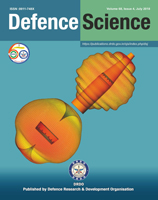Study of Wavefront Tilt Variance with Various Telescope Apertures in Indoor Convective Turbulence
DOI:
https://doi.org/10.14429/dsj.68.11862Keywords:
Adaptive optics, Wavefront tilt variance, Convective turbulence, Hurst exponent, Fried parameter, Non-Kolmogorov,Abstract
Turbulent atmosphere produces random wavefront tilt in the propagating laser beam and the dynamics of turbulence is largely depend on the receiving optics aperture size. In this paper, wavefront tilt variance is studied with various telescope aperture sizes in indoor convective turbulence. A simple experimental setup is described for simulating the near ground atmospheric turbulence by generating different strengths of convective turbulence in the laboratory. A laser beam is made to propagate through the turbulence subsequently induced wavefront tilt variances are experimentally measured and analyzed statistically. The wavefront tilt variance is used to estimate the temporal characteristics using Fourier transform by varying aperture sizes and turbulence strengths (i.e. ambient, weak and moderate). The Hurst exponent, the Fried parameter and the wavefront tilt frequencies for the different turbulence strengths are calculated. The power dependence of the wavefront tilt variance on the telescope aperture size is studied and a deviation from the classical D-1/3 dependence is reported.References
Tyson, R. K. Principle of Adaptive Optics., Third Ed., CRC press, Boca Raton, 2011.
Scharmer, G. B.; Dettori, P. M.; Lofdahl, M. G. & Shand, M. Adaptive optics system for the new Swedish solar telescope. In Proceedings of Astronomical Telescopes and Instrumentation SPIE, 2003, 370-380. doi:10.1117/12.460387
Hammer, D. X.; Ferguson, R. D.; Bigelow, C. E.; Iftimia, N. V.; Ustun, T. E. & Burns, S. A. Adaptive optics scanning laser ophthalmoscope for stabilized retinal imaging. Opt Exp, 2006, 14 (8), 3354-3367. doi: 10.1364/OE.14.003354
Samarkin, V. & Kudryashov, A. Deformable mirrors for laser beam shaping. In Proceedings Optical Engineering+Applications SPIE, 2010, 77890B. doi:10.1117/12.863965
Downloads
Published
How to Cite
Issue
Section
License
 Where otherwise noted, the Articles on this site are licensed under Creative Commons License: CC Attribution-Noncommercial-No Derivative Works 2.5 India
Where otherwise noted, the Articles on this site are licensed under Creative Commons License: CC Attribution-Noncommercial-No Derivative Works 2.5 India


